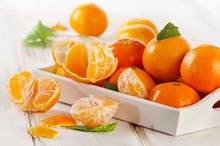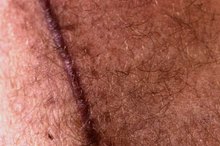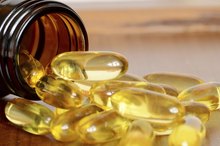What does fact checked mean?
At Healthfully, we strive to deliver objective content that is accurate and up-to-date. Our team periodically reviews articles in order to ensure content quality. The sources cited below consist of evidence from peer-reviewed journals, prominent medical organizations, academic associations, and government data.
The information contained on this site is for informational purposes only, and should not be used as a substitute for the advice of a professional health care provider. Please check with the appropriate physician regarding health questions and concerns. Although we strive to deliver accurate and up-to-date information, no guarantee to that effect is made.
Fruits That Heal Wounds
Researchers at the University of Michigan report that fruits high in antioxidants, nutrients and vitamins aid in the healing process of wounds. Phytochemicals, for example, help to safeguard the body from disease while shortening recovery time. One serving of fruit contains over 100 phytochemicals in addition to vital nutrients and vitamins. Eating specific fruit varieties helps to facilitate the healing process by delivering the necessary compounds for a speedy recovery.
Lemons, Limes and Oranges
Lemons, limes and oranges are extremely high in vitamin C, which, according to the National Institutes of Health, is essential for healing wounds 12. Vitamin C is an antioxidant that blocks damages caused by free radicals--the by-products of the food into energy process. In addition, it is responsible for the repair and maintenance of teeth and bones. The human body does not store or create this vitamin on its own, so it is extremely important to regularly consume lemons, limes and oranges as they are the fruits with the highest concentration of vitamin C. The skins of lemons and limes contain the compounds limonin and limonene, which inhibit cellular damage. Consider adding the zest of these fruits to your drinks or salads to improve healing rates.
- Lemons, limes and oranges are extremely high in vitamin C, which, according to the National Institutes of Health, is essential for healing wounds 1.
- The human body does not store or create this vitamin on its own, so it is extremely important to regularly consume lemons, limes and oranges as they are the fruits with the highest concentration of vitamin C. The skins of lemons and limes contain the compounds limonin and limonene, which inhibit cellular damage.
Apples
Citric Acid & Weight Loss
Learn More
Apples contain high levels of vitamin A, which help to form and maintain healthy teeth, tissues, mucous membranes and skin. Additionally, apples have antiviral properties to ward off infection and healing. A recent University of Illinois study found that the anti-inflammatory protein, interleukin-4, found in apples aids in soothing agitated cells during infection. The soluble fiber and vitamin A combination boosts the immune system and encourages recovery.
- Apples contain high levels of vitamin A, which help to form and maintain healthy teeth, tissues, mucous membranes and skin.
- A recent University of Illinois study found that the anti-inflammatory protein, interleukin-4, found in apples aids in soothing agitated cells during infection.
Avocados
The Centers for Disease Control and Prevention advocate consuming avocados as part of a healthy diet. Avocados are packed full of nutrients ranging from vitamin C, fiber, magnesium, and most importantly, vitamin E. Vitamin E is a powerful antioxidant that helps prevent the degeneration of cellular tissue. More interestingly, however, is the application of vitamin E both through food and topical agents. Applying vitamin E to scars stimulates skin rejuvenation and reduces the appearance of scars left by healing wounds.
- The Centers for Disease Control and Prevention advocate consuming avocados as part of a healthy diet.
- Applying vitamin E to scars stimulates skin rejuvenation and reduces the appearance of scars left by healing wounds.
Related Articles
References
- National Institutes of Health: Vitamin C
- National Institutes of Health: Vitamin A
- Science Daily: An Apple a Day
- Davey, M. W., Montagu, M. V., Inzé, D., Sanmartin, M., Kanellis, A., Smirnoff, N., ... & Fletcher, J. (2000). Plant Lâascorbic acid: chemistry, function, metabolism, bioavailability and effects of processing. Journal of the Science of Food and Agriculture, 80(7), 825-860.
- Alessio, H. M., Hagerman, A. E., Fulkerson, B. K., Ambrose, J. E. S. S. I. C. A., Rice, R. E., & Wiley, R. L. (2000). Generation of reactive oxygen species after exhaustive aerobic and isometric exercise. Medicine and Science in Sports and Exercise, 32(9), 1576-1581.
- Padayatty, S. J., Katz, A., Wang, Y., Eck, P., Kwon, O., Lee, J. H., ... & Levine, M. (2003). Vitamin C as an antioxidant: evaluation of its role in disease prevention. Journal of the American College of Nutrition, 22(1), 18-35.
- Bendich, A., & Langseth, L. (1995). The health effects of vitamin C supplementation: a review. Journal of the American College of Nutrition, 14(2), 124-136.
- Douglas, R. M., & Hemilä, H. (2005). Vitamin C for preventing and treating the common cold. PLoS Medicine, 2(6), e168.
- Bryer, S. C., & Goldfarb, A. H. (2006). Effect of high dose vitamin C supplementation on muscle soreness, damage, function, and oxidative stress to eccentric exercise. International Journal of Sport Nutrition and Exercise Metabolism, 16(3), 270-280.
- Nakhostin-Roohi, B., Babaei, P., Rahmani-Nia, F., & Bohlooli, S. (2008). Effect of vitamin C supplementation on lipid peroxidation, muscle damage and inflammation after 30-min exercise at 75% VO^ sub 2max^. Journal of Sports Medicine and Physical Fitness, 48(2), 217.
- Li, H., Zou, Y., & Ding, G. (2012). Dietary factors associated with dental erosion: a meta-analysis. PloS One, 7(8), e42626.
- Moertel, C. G., Fleming, T. R., Creagan, E. T., Rubin, J., O'Connell, M. J., & Ames, M. M. (1985). High-dose vitamin C versus placebo in the treatment of patients with advanced cancer who have had no prior chemotherapy: a randomized double-blind comparison. New England Journal of Medicine, 312(3), 137-141.
- Bruno, R. S., Leonard, S. W., Atkinson, J., Montine, T. J., Ramakrishnan, R., Bray, T. M., & Traber, M. G. (2006). Faster plasma vitamin E disappearance in smokers is normalized by vitamin C supplementation. Free Radical Biology and Medicine, 40(4), 689-697. .
- Huang, J., & May, J. M. (2003). Ascorbic acid spares α-tocopherol and prevents lipid peroxidation in cultured H4IIE liver cells. Molecular and Cellular Biochemistry, 247(1), 171-176.
- Kalgaonkar, S., & Lönnerdal, B. (2008). Effects of dietary factors on iron uptake from ferritin by Caco-2 cells. The Journal of Nutritional Biochemistry, 19(1), 33-39.
- Monsen, E. R. (2000). Dietary reference intakes for the antioxidant nutrients: vitamin C, vitamin E, selenium, and carotenoids. Journal of the American Dietetic Association, 100(6), 637-640.
Writer Bio
Skyler White is an avid writer and anthropologist who has written for numerous publications. As a writing professional since 2005, White's areas of interests include lifestyle, business, medicine, forensics, animals and green living. She has a Bachelor of Arts in anthropology from San Francisco State University and a Master of Science in forensic science from Pace University.









